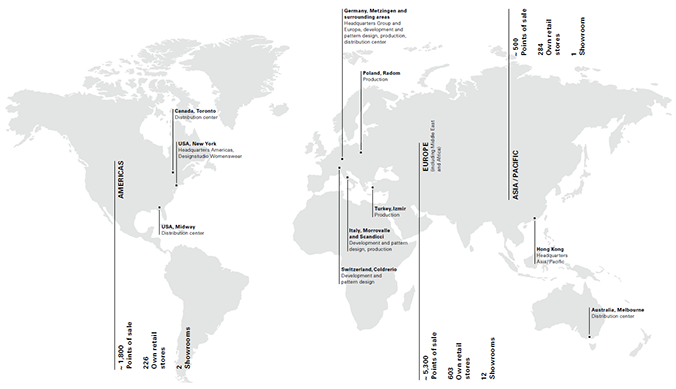Legal structure of the Group reflects dual management and control structure
The HUGO BOSS Group is managed by the parent company HUGO BOSS AG, based in Metzingen, Germany, where all of the Group management functions are bundled. HUGO BOSS AG as a German stock corporation has a dual management and control structure. The Managing Board is responsible for the Group’s strategy and its management, while the Supervisory Board advises the Managing Board and monitors its management activities. In addition to HUGO BOSS AG, the Group is made up of 56 consolidated companies that hold sole responsibility for local business activities. Of these, 34 subsidiaries are organized as distribution companies. Aside from a few exceptions, HUGO BOSS AG has complete control over all subsidiaries.
Regional alignment of organizational structure
The HUGO BOSS Group is organized by regions, with the business units assigned to three regional organizational units: Europe including the Middle East and Africa, the Americas and Asia/Pacific. The purpose of this structure is to tap market potential and to boost local business. In addition to these three regions, the Group’s license business constitutes a fourth operating segment. Responsibility for the corporate functions is allocated to the individual members of the Managing Board and therefore concentrated at the Group’s headquarters.
MANAGING BOARD |
||
CENTRAL FUNCTIONS |
OPERATIVE SEGMENTS |
|
Brand Management |
EUROPE |
|
Communication |
||
Creative Management |
||
Finance and Controlling |
AMERICAS |
|
Human Resources |
||
Investor Relations |
||
IT |
ASIA/PACIFIC |
|
Legal, Compliance and Risk Management |
||
Licenses |
||
Logistics |
LICENSES |
|
Own Retail |
||
Sales |
||
Sourcing and Production |
||
Regional organizations implement Group strategy
In each of the three regional organizational units, the regional director is responsible for implementing the Group’s strategy in the applicable market. Within the regions they are heading, the directors are responsible in close cooperation with the country managers for the regional adaptation of the distribution strategy in the Group’s own retail business and the wholesale business, as well as for the development of sales and earnings. These regional distribution structures strengthen the Group’s proximity to customers, improve responsiveness to market trends and facilitate adjustment to market specifics. They also enable a fast exchange of knowledge through the close integration of the local companies.
